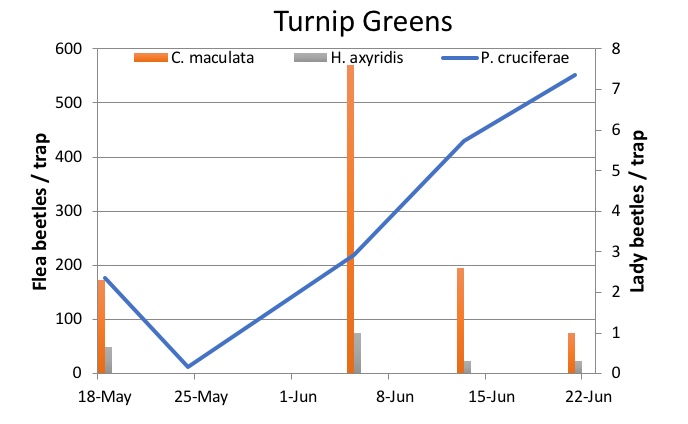Journal of the NACAA
ISSN 2158-9429
Volume 11, Issue 2 - December, 2018
Using Sticky Traps to Control Flea Beetles on Two Ohio Urban Farms
- Jasinski, J. , Extension Educator, OSU Extension
Kowalski, J., Extension Educator, OSU Extension
ABSTRACT
Urban agriculture is on the rise in many communities throughout Ohio. Despite being isolated from traditional agricultural and horticultural production, some common vegetable pests are found in these enterprises at similar or higher levels of infestation compared to nearby diversified commercial farms in rural areas. With most urban farmers averse to pesticide use to manage insects, weeds, and diseases, many only use minimal inputs with a heavy reliance on physical and cultural controls to manage pests. This study looked at the effects of using white and yellow sticky traps to manage flea beetle populations in cruciferous and solanaceous crops at two sites in 2017. Although the sticky traps removed thousands of flea beetles from one site, crop damage was generally high; sticky trap captures of flea beetles and overall crop damage were much lower at the second site.
Introduction
At a national level, urban agriculture farming is broadly defined as the production, processing, and distribution of fruits and vegetables within the city limits (Bailkey and Nasr, 2000; Santo et al, 2016). These farms range in size from residential lots to multi-acre enterprises, and have been steadily increasing in number in cities and towns of all sizes across the country. Ohio can be viewed as a microcosm of the national trend, with over 65 documented urban farms currently operating in Cincinnati, Columbus, and Cleveland alone. In 2013 a national urban agriculture survey was conducted with 315 operations responding in order to determine the challenges and technical assistance needed by this population of growers (Oberholtzer et al., 2014). While this number vastly underrepresents the number of urban farms in the country, the survey found that urban farms use a variety of production practices and systems, e.g. raised beds, containers, high tunnels, etc., to produce food.
Most urban farms tend to be located in heavily developed landscapes surrounded by houses, buildings, pavement, and roads. With relatively few herbaceous plants, shrubs and trees in the immediate landscape, including little if any vegetable or fruit production, it is generally assumed there is a reduced risk of pests. However, in the national urban agriculture survey, pest and weed management ranked second and third as overall challenges, right behind production costs (Oberholtzer et al., 2014). To validate that statement, in 2016, flea beetles, imported cabbage worm caterpillars and cabbage aphids were observed in such high numbers at urban farms in Dayton and Akron, that certain crops could not be harvested and needed to be destroyed.
After experiencing one season of major crop damage and substantial harvest loss, urban growers at these sites contacted The Ohio State University Extension for help in managing these pests and mitigating crop losses. Extension educators began to work with these urban growers to understand some of the basics tenets regarding integrated pest management (IPM). Growers and volunteers at each location were taught the basics of pest management such as scouting, monitoring, pest identification and biology, in both formal classroom settings and informally during several on-site farm visits throughout 2017.
One of the main principles in IPM is to identify cultural, biological, and chemical management practices for each crop in order to reduce pest pressure (USDA, 2018). Since these two farms did not want to use any pesticides for insect control, several organic pest management programs suggest managing flea beetle populations using yellow and white sticky traps as a cultural control option (Burkness and Hahn, 2007; Parker et al., 2012; Parker and Snyder, 2017). Colored sticky traps are known to be attractive a broad spectrum of insects, including this pest.
To test the effectiveness of using only sticky traps to manage flea beetle populations, the two urban farms in Dayton and Akron that experienced high levels of infestation and damage in 2016 elected to participate in this study. The goal of the study was to see if flea beetle populations and their subsequent damage could be managed to an acceptable level by deploying white and yellow sticky traps in turnip green, collard, kale, and eggplant crops grown in raised beds.
Methods
At the first site, The Urban Renewal Farm (TURF) in Dayton, flea beetles were monitored in crops grown in raised beds measuring 36’ x 4’ x 1.5’ placed on an asphalt parking lot of an abandoned factory downtown (Figure 1). Yellow sticky traps attached to wooden strips were deployed four feet apart and placed in the center of each raised bed between or just above the crop canopy to attract and capture crucifer flea beetles (Phyllotreta cruciferae) near collards, turnip greens, and kale. White sticky traps were deployed in the same way for the eggplant crop to capture eggplant flea beetles (Epitrix fuscula) (Figure 2). Weekly visits from May 18 –July 20 were made to TURF to count two species of flea beetles and two species of common lady beetles (Coleomegilla maculata and Harmonia axyridis) captured on the sticky traps. Coleomegilla maculata and Harmonia axyridis are common lady beetles and generalist natural enemies of many pests. After identifying and counting all four target insects, the sticky traps were replaced, and the extent of foliar feeding on each crop was estimated from none to severe (Figure 3).

Figure 1. Aerial view of The Urban Renewal Farm in Dayton, OH.

Figure 2. Sticky trap deployment over various crops and close up of trap catch at The Urban Renewal Farm in Dayton, OH.

Figure 3. Foliar damage (A) caused by either Phyllotreta cruciferae (B) or Epitrix fuscula (C) flea beetles.
At the second site, Let’s Grow Akron in Akron, flea beetles were also monitored in crops grown in raised beds measuring 24’ x 4’ x 1’ placed on a neighborhood vacant lot (Figure 4). Seedlings were transplanted on June 1 and traps were deployed at the same time. Both yellow and white sticky traps were attached to wooden strips placed between plants in the center of the beds growing kale and eggplant, alternating colors at six-foot intervals to capture crucifer and eggplant flea beetles present around those crops. Traps were checked and replaced on a monthly basis in late June, July and August, with the used sticky traps taken back to the office where flea beetles and other pests such as Mexican bean beetles (Epilachna varivestis) were counted. When the traps were replaced each month, the extent of flea beetle damage on the crop was indexed as none, moderate or severe.
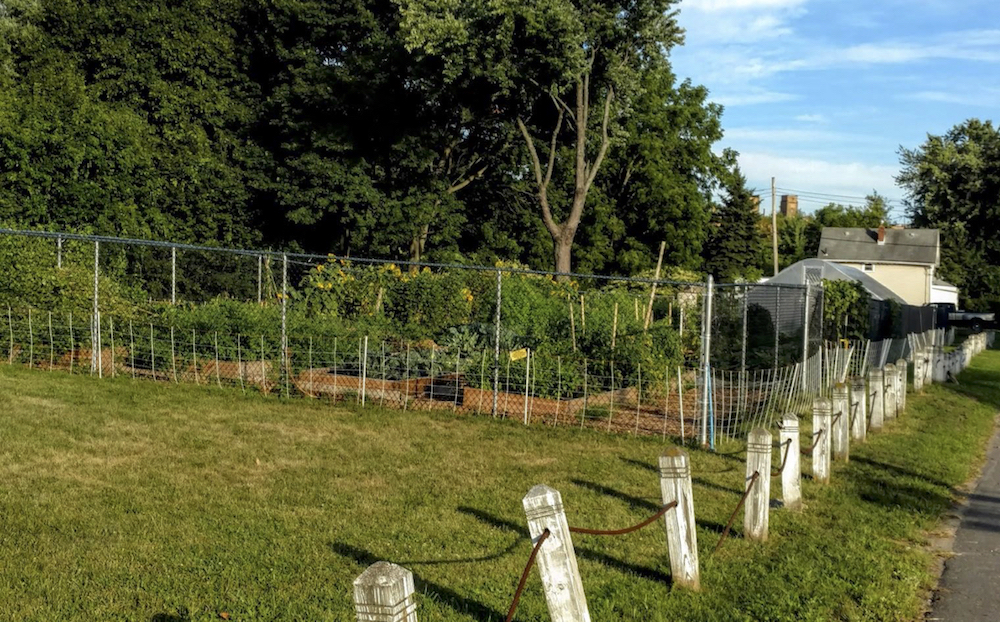
Figure 4. Street view of Let's Grow Akron urban farm, Akron, OH.
Results
At the Dayton farm, crucifer flea beetle pressure was highest on collard and turnip green crops, reaching a peak of 517 and 552 beetles/trap/week, with kale reaching a peak of 312 beetles/trap/week (Figures 5-7). Peak eggplant flea beetle populations on eggplant were much lower at 127 beetles/trap/week. Direct damage to the crop leaves by the flea beetles were visually assessed as moderate to severe throughout the season on turnip greens, collards, and kale, but damage to eggplant foliage was categorized as low (Figure 8). C. maculata captures peaked at 7.6 beetles/trap/week on June 5 while H. axyridis captures peaked at 2 beetles/trap/week on June 21.
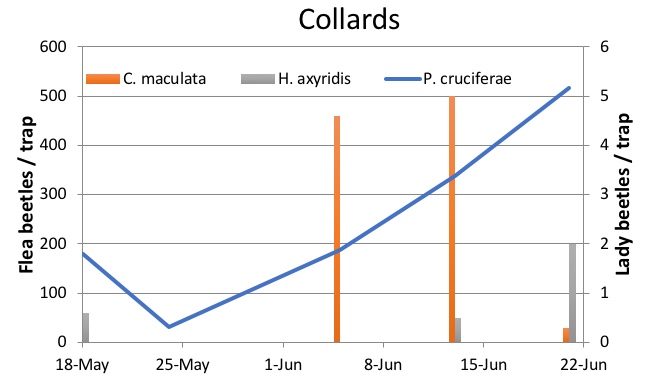
Figure 5. Yellow sticky trap catches of crucifer flea beetle (P. cruciferae) and two species of lady beetles (C. maculata and H. axyridis) in collards at The Urban Renewal Farm, Dayton OH.
Figure 6. Yellow sticky trap catches of crucifer flea beetle (P. cruciferae) and two species of lady beetles (C. maculata and H. axyridis) in turnip greens at The Urban Renewal Farm, Dayton OH.
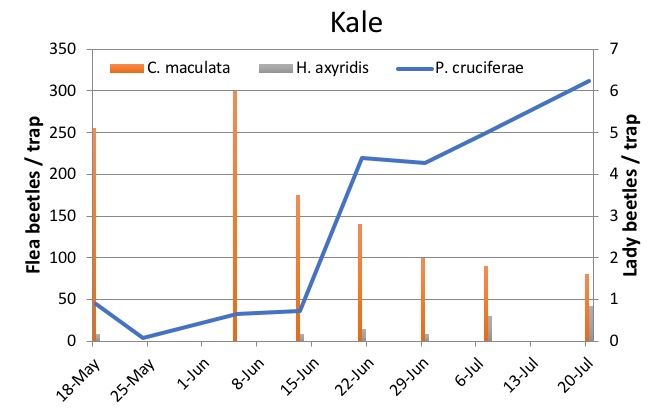
Figure 7. Yellow sticky trap catches of crucifer flea beetle (P. cruciferae) and two species of lady beetles (C. maculata and H. axyridis) in kale at The Urban Renewal Farm, Dayton OH.
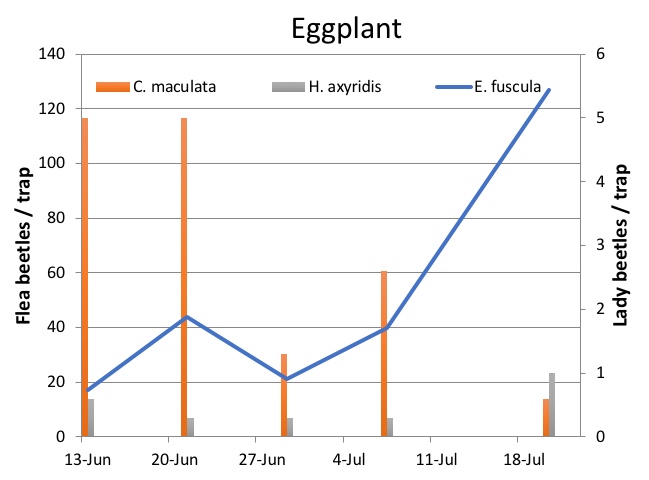
Figure 8. White sticky trap catches of eggplant flea beetle (E. fuscula) and two species of lady beetles (C. maculata and H. axyridis) in eggplant at The Urban Renewal Farm, Dayton OH.
At the Akron farm, crucifer flea beetle pressure was lower on kale, with peak catches of 125 and 134 beetles/trap/month on yellow and white sticky traps respectively (Figure 9). Eggplant flea beetles on eggplant were only slightly higher, peaking at 140 and 138 beetles/trap/month on yellow and white sticky traps respectively (Figure 10). Leaf damage to both crops was minimal except for a few unmarketable leaves of kale. Other pest insects such as the Mexican bean beetle were noted on the traps at a density of <2 beetles/trap/month.
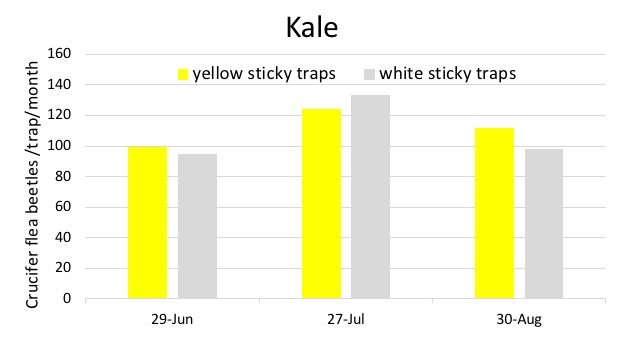
Figure 9. Monthly trap catches of crucifer flea beetle in kale at the Let's Grow Akron site, Akron OH.
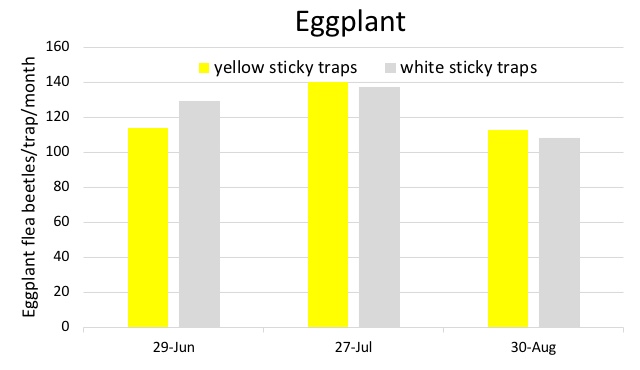
Figure 10. Monthly trap catches of eggplant flea beetle in eggplant at the Let's Grow Akron site, Akron OH.
Discussion and Conclusion
Depending on geography, seasonal weather and production practices, urban farmers can face high pest pressure on certain crops but may be reluctant to use pesticides in favor of cultural controls such as row covers, sticky traps, physical removal or crop rotation.
In 2017, crucifer flea beetle populations rose steadily at the Dayton farm for nearly the entire monitoring period aided by 6.52 inches of rain and a high average temperature of 77-81°F. Although yellow sticky traps removed over 14,234 crucifer flea beetles from the site, substantial feeding damage was done to the leaves of the cruciferous crops. White sticky traps also removed 746 eggplant flea beetles from the site, but the eggplant foliage was only lightly damaged. One reason for such high flea beetle pressure at this site may be the lack of crop rotation between the raised beds that grew flea beetle susceptible crops in 2016. Row covers would not have helped protect any of the crops as the overwintering beetles were already in the raised bed soil from the previous year.
Although two species of lady beetles were present at the Dayton site, they did not seem to have an impact on the flea beetle population. This is likely because flea beetle larvae live in the soil and are largely inaccessible to above ground generalist predators, and flea beetle adults are not known to be a major prey item of lady beetles.
The Akron site had trapped substantially fewer crucifer flea beetles but similar numbers of eggplant flea beetles compared to the Dayton site. Only minor amounts of foliar damage were sustained on both kale and eggplant crops despite having weather conducive to pest development with 2.75 inches of rain and a high average temperature of 80-82°F during the monitoring period. Results from this site indicate that sticky traps may help moderate crop damage under light pressure from either species but this would need to be validated in future studies. In addition, careful planning of crop rotation at this site from 2016 to 2017 and avoiding planting susceptible crops in beds where flea beetles were overwintering, may have reduced the surviving spring population. It is unclear if planting later than usual affected flea beetle pressure but shifting the planting date is a viable IPM practice. With any susceptible crop and rapidly reproducing pest, early season control is very important to prevent large populations as the season progresses and the crop matures.
While the use of conventional synthetic pesticides to control these pests was avoided by the urban farmers we worked with, this non-chemical approach is similar to some community gardeners who do not take any steps to manage pests or diseases (Gregory and Drinkwater, 2016). As an alternative to no pesticide use, growers might be interested in using Organic Material Review Institute approved pesticides that generally have lower environmental impact. There is a need for continued education of sound IPM principles, monitoring, identification, tactics, etc., that will benefit growers as they manage pests in their operations. In the true spirit of IPM, the integration of multiple tactics including rotation, row covers, sticky traps and judicious use of pesticides if necessary would likely serve most urban farmers better as a strategy to manage pests, ultimately providing higher quality produce. Anecdotally, many urban food buyers such as restaurants and cafes accept a moderate amount of pest damage on the crops they purchase as evidence that no pesticides were used during production, sometimes a condition of purchase. The move away from cosmetically perfect produce may allow a greater range of cultural controls to be used in these markets effectively.
Literature Cited
Bailkey, M., and Nasr, J. (Fall 1999/Winter 2000). From brownfields to greenfields: Producing food in North American cities. Community Food Security News, 6-8.
Burkness, S. and Hahn, J. (2007). Flea Beetles in Home Gardens. University of Minnesota Extension Publication M1210. https://extension.umn.edu/yard-and-garden-insects/flea-beetles.
Gregory, M., Leslie, T., and Drinkwater, L. (2016). Agroecological and social characteristics of New York city community gardens: contributions to urban food security, ecosystem services, and environmental education. Urban Ecosystems, 19(2):763-794.
Oberholtzer, L., Dimitri, C., and Pressman, A. (2014). Urban Agriculture in the United States: Characteristics, Challenges, and Technical Assistance Needs. Journal of Extension [On-Line], 52(6) Article 6FEA1.https://joe.org/joe/2014december/pdf/JOE_v52_6a1.pdf.
Parker, J., Miles, C., Murray, T., and Snyder, W. (2012). Organic management of flea beetles. Washington State University, Oregon State University, and University of Idaho Extension Publication PNW640. http://cru.cahe.wsu.edu/CEPublications/PNW640/PNW640.pdf.
Parker, J. and Snyder, W. (2017). Managing cruciferous and solanaceous flea beetles in organic farming systems. eXtension. https://articles.extension.org/pages/72972/managing-cruciferous-and-solanaceous-flea-beetles-in-organic-farming-systems.
Santo, R., Palmer, A. and Kim, B. (2016). Vacant lots to vibrant plots: A review of the benefits and limitations of urban agriculture. Johns Hopkins Center for a Livable Future. https://www.jhsph.edu/research/centers-and-institutes/johns-hopkins-center-for-a-livable-future/_pdf/research/clf_reports/urban-ag-literature-review.pdf
U. S. Department of Agriculture (2018). A National Roadmap for Integrated Pest Management. https://www.ars.usda.gov/ARSUserFiles/OPMP/IPM%20Road%20Map%20FINAL.pdf.
Acknowledgement
This project was partially supported by USDA National Institute of Food and Agriculture, 20177000627174.

